Three-train crash in Pennsylvania leaked diesel and plastic pellets into waterways
A three-train crash in Pennsylvania, US, has spilled diesel fuel and plastic pellets into the nearby Lehigh river, a Delaware river tributary that provides drinking water for hundreds of thousands of people.
All three trains were operated by Norfolk Southern, which also operated the freight train that derailed in the Ohio town of East Palestine in February 2023, spilling its load of hazardous chemicals, the long-term health and environmental impacts of which still remain unclear.
A spokesperson for the US National Transportation Safety Board has stated to the media that there are no reported injuries or leaks of hazardous materials in the latest incident.
But there is some scepticism and frustration on the part of researchers like Andrew Whelton, an environmental chemist and engineering professor at Purdue University in Indiana, US, who studies environmental disasters, polymer science, water quality, and public health. He was not surprised about this latest incident.
Officials need to decide whether it’s acceptable that chemicals in transport enter the environment under preventable circumstances
‘What officials need to decide upon is whether or not it’s acceptable that chemicals in transport enter the environment under preventable circumstances,’ Whelton tells Chemistry World. ‘We know that after the train derailment, chemical spill and chemical fires in East Palestine, there was a lot of talk about improving the safety of chemical transport by rail through legislation, but nothing has happened at the federal level to bring together that type of improved policy.’
The Pennsylvania incident was comparatively minor. Nevertheless, Whelton notes that when plastic pellets – sometimes called ‘nurdles’ – are released into the environment they can contribute to microplastic pollution. Generally, microplastics are not recoverable once they get too far away from the spill site, he adds.
‘When they’re dumped into the waterway, then everything that you’ve heard about with the fate of microplastics in the environment and where they go is possible,’ he states. Furthermore, he says emergency responders generally treat microplastics as inert materials, unlike diesel fuel that is a recognised mixture of different compounds, some of which will dissolve or disperse into the water then flow downstream. ‘There’s no chemical or downstream testing to figure out what concentrations are present, how much weight was recovered, how many pellets were lost into the environment.’
‘There’s always going to be a challenge with chemical safety transport, and this incident in Pennsylvania reaffirms that,’ Whelton states.
There was a lot of talk about improving rail transport safety through legislation, but nothing has happened at the federal level
Judith Enck, founder of environmental campaign group Beyond Plastics, agrees. She notes that there was another significant spill of plastic pellets from a Norfolk Southern train in February – on the Hoosick River in upstate New York.
‘With the increase in movement of plastic nurdles on the nation’s rickety rail system, regulators need to do a much better job preventing these incidents and being ready with a more robust emergency response,’ she states. ‘We cannot allow rivers and bays to slowly become plastic landfills, which is what is happening today.’
‘Little to no progress’
Although the most recent train derailment was relatively small, Whelton says it ‘underscores that little to no progress has been made’ since the disaster a year ago in East Palestine, which affected five states and resulted in billions of dollars in clean-up expenditure.
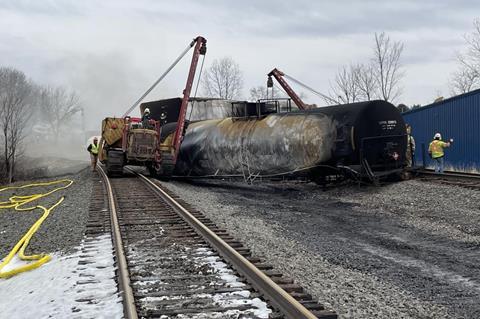
The EPA has reaffirmed its assessment in the aftermath of the East Palestine derailment, stating that levels of worrisome chemicals in the air and water in that area are safe.
‘After review of over 115 million monitoring points and tens of thousands of environmental sample results since the evacuation was lifted, what we have determined is that the individual concentrations of the chemicals found in East Palestine from the derailment pose a very low risk to human health,’ the agency said in a statement. ‘If any outside expert has credible science to show that people are in danger, we stand ready to examine that science and engage constructively, as we’ve done with a host of other advocates and community representatives.’
But Whelton remains incredulous. ‘We know for certain that first responders were exposed to chemicals and some were injured, as well as residents and visitors to town, including myself,’ he notes. ‘All these folks got sick, so it doesn’t matter how many samples were collected, [they] obviously didn’t know what [they] were looking for or didn’t use the right equipment.’
Once residents were cleared to return to their homes after being evacuated for about five days after the East Palestine derailment, many reported symptoms like headaches, coughs and nausea.
The takeaway from East Palestine, according to Whelton, is that people still got sick despite the extensive government agency data collection. ‘What they were exposed to, and the concentrations of those chemicals, remains somewhat of a mystery right now because many of the universities that did go in and conduct sampling haven’t published their data yet,’ he adds. ‘At the time, there was really no financial support for these universities to do that kind of work.’ Whelton estimates that he himself racked up $200,000 (£157,000) in bills for hotels and other expenses related to investigating the incident’s fallout.
The EPA says it has been coordinating with the US National Institutes of Health since early last spring to support rapid research targeted to the health concerns raised by some community members. In addition, the agency vows to continue to provide information and data to the independent researchers conducting important work in this area.





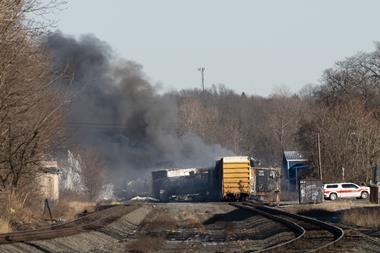
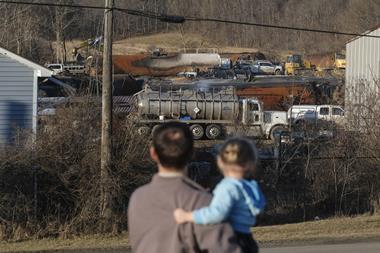

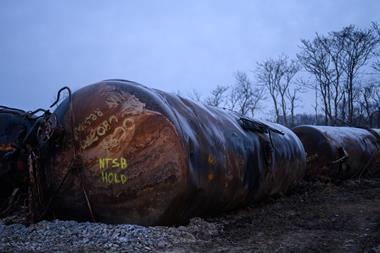

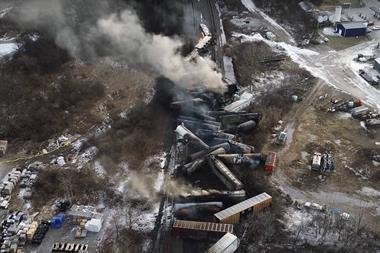






No comments yet